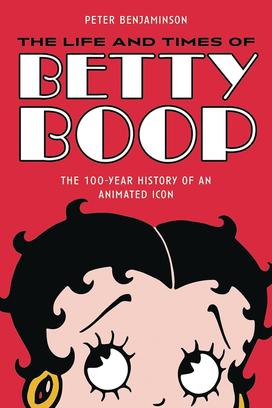Peter Benjaminson *77 Traces History of Beloved Icon Betty Boop
The book: Focused on an original American icon, The Life and Times of Betty Boop (Applause Books) is a lively account of the beloved character’s history. Beginning with her creation by the artists of the animation shop Fleischer Studios, which was competing with Disney, author Peter Benjaminson traces Betty’s evolution. (Did you know Betty Boop was originally designed as an anthropomorphic French poodle?) Benjaminson highlights what contributed to Betty’s enduring affection as her fame continued through the generations.

The author: Peter Benjaminson *77 began his career working as a reporter. Several hundred of his articles appeared in The Los Angeles Times, The Detroit Free Press, and the Atlanta Journal-Constitution before he began writing for popular magazines including Rolling Stone. He taught journalism at Binghamton University, New York University, and Columbia University, and worked in various communications roles in New York City. He’s the author of several books including Investigative Reporting and The Story of Motown.
Excerpt:
BETTY BOOP AND BIMBO
Betty Boop started her on-screen cartoon life as a girlfriend for Bimbo the dog-man, an already existing Fleischer Studios cartoon star, whom the Fleischers had created as an answer to Walt Disney’s Mickey Mouse. (The Fleischers were shrewd to pick a dog-like person to star with Betty rather than a mouse, which had been Disney’s choice. Very few Americans love mice, but millions of American families in the 1930s owned and loved dogs.)
In any case, Bimbo was a pretty advanced mutt. Although clearly a canine, he wore clothes, spoke English, played musical instruments with his forepaws, walked on his hind legs, and otherwise acted completely human. Nevertheless, as a dog-man he needed a partly doggy girlfriend.
In the cartoon “Hot Dog,” released on March 29, 1930, in which Bimbo starred and in which Betty did not appear, Bimbo was shown out driving and trying to pick up women walking on the sidewalk. At the time, “hot dog” was slang for “attractive woman.” Appropriately enough, considering this quest of Bimbo’s, his name had two different meanings at the beginning of his cartoon career. When he was first dubbed “Bimbo,” that word meant a tough guy, or a criminal. Soon after Bimbo’s character began appearing on the screen, however, “bimbo” came to mean a promiscuous female. Whether or not this shift in meaning was partly prodded by Bimbo’s relentless on-screen pursuits, it underscored his interest in women.
The title of this cartoon also may have been a subtle Fleischer reference to the competition between Mickey Mouse and Bimbo. Their rivalry had begun the previous year when Mickey’s first cartoon, “The Karnival Kid,” was released on May 23, 1929, and “Hot dogs! Hot dogs!” were Mickey’s first on-screen comments in it. He wasn’t referring to women, however, since he’d been speaking these words while selling frankfurters at a carnival.
In the “Hot Dog” cartoon, Bimbo soon focuses on one female he thinks might be attractive. When she turns out to be ugly and mostly toothless, he tries to escape her by tunneling under the pavement in his car. That move attracts police attention, but unaware of their official interest, Bimbo then focuses on a bosomy young woman roller skating down the street, lures her into his vehicle, and attempts to romance her. Unfortunately for Bimbo, the young woman isn’t interested and soon escapes on her skates. He pursues her on foot but then is nabbed by the cops and hauled into court for digging holes in the public street with his car.
Once in court, Bimbo escapes a penalty by producing a banjo out of nowhere, dancing a few steps, and singing portions of “St. Louis Blues.” The song, strictly speaking, is unrelated to the offense for which Bimbo’s been arrested, but he obviously hopes to gain the court’s sympathy by singing it as part of his defense. (The Fleischers apparently thought “St. Louis Blues” would be particularly appropriate to this cartoon because it deals with unrequited love.) The male judge and the all-male jury listen intently, and then dance to Bimbo’s performance. Naturally, he leaves court unpenalized.
While Bimbo has no further legal problems that day, his sexual predicament remains obvious: How many women want a dog, or even a dog-man, for a lover? Maybe some novelty seekers, but they’re hard to find.
The cartoon version of Betty was created to fill this need. Early one morning in 1930, Dave Fleischer told animator Grim Natwick to design a girl dog who would costar with Bimbo in a cartoon to be titled “Dizzy Dishes.” Natwick was told that the new character, as yet unnamed, would be singing a “boop-oop-a-doop” song similar to those sung by Helen Kane. Fleischer also handed Natwick a picture of Kane. Having been told to create a female dog for Bimbo, Natwick drew a poodle named Betty who walked on four legs and sported a pelvic-shaped human head complete with long dangling ears, canine jowls, and a button nose. Above Betty’s ears, however, he provided her with one of the popular feminine hairstyles of the day, singer and actress Helen Kane’s spit curls.
Fleischer took one look at Natwick’s outlandish creation and ordered him to turn the character’s body into that of a woman. Natwick immediately ripped the head he’d created off its doggy torso and perched it on the body of a human female, Betty Boop. “I put cute, feminine legs on her,” Natwick said later. The woman he’d drawn was now all girl, at least from the tips of her toes to the top of her torso. The problem began just above her shoulders. She sported a doggy-type nose, doggy ears, doggy jowls, and no neck.
Why Natwick decided not to provide Betty with a neck has been lost in the annals of animation history. Many of her subsequent animators complained that it was hard for her to move realistically from place to place with no neck to steer herself by. Her head stayed in one position while her legs moved all over the place. This was also a problem for many of Betty’s fans, because it meant that she rarely, if ever, kissed any of her on-screen admirers. There’s a reason kissing is sometimes called “necking”: it’s very difficult to do the former without using the latter, and Betty just didn’t have the equipment. She definitely expressed her affection for men, but almost always in other ways.
Natwick’s fellow animators would eventually solve Betty’s neck problem. They perfected the animation of Betty in profile so her cartoon head would move in conjunction with the rest of her body, even though she had no neck.
Betty, making her first appearance in “Dizzy Dishes,” sings to Bimbo, who is working in the restaurant as a waiter and a chef. “I have to have lovin’,” Betty sings to Bimbo from the stage. “I have to have you.”
The lyrics were from the song “I Have to Have You,” written by Leo Robin and performed by Helen Kane in the 1929 musical comedy film “Pointed Heels,” in which she costarred with William Powell and Fay Wray.
What Kane sang in her movie was “Sometimes I get so blue waiting for you to take me. I can’t go on like this!” Betty, while bending forward and staring straight at Bimbo, sings “I’m so blue, waiting for you, to [indecipherable] me. I can’t go on like this.” The Fleischers just couldn’t bring themselves to show Betty asking a dog-man to “take” her.
Betty then flips up the back of her dress several times in a way that inevitably evokes the position that dogs, and presumably some dogmen, use to consummate their relationships. Bimbo certainly seems to get the message. He responds to Betty’s attentions by enthusiastically dancing in place and accompanying her on a ukulele. He also sings her chosen phrase, “boop-boop-a-doop” right back at her. All this would seem quite promising, except that Bimbo leaves the premises soon after this exchange, apparently having completely forgotten about Betty. Some dog-men are like that.
Audiences didn’t forget about Betty, however.
From The Life and Times of Betty Boop by Peter Benjaminson. Copyright © 2023 by Peter Benjaminson and published by Applause Books. All rights reserved.
Reviews:
“The author more than makes the case that Betty Boop maintains long-lasting appeal and popularity, thanks to her indelible charm and independence. A fascinating read that explores every facet of the animated icon.” — Claire Sewell, Library Journal












No responses yet